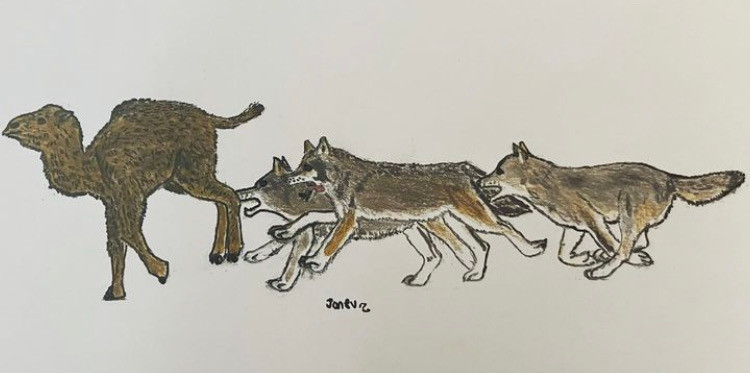HOME | DD
 demonlemurz — Red Wolves Hunting Camelops Calf
demonlemurz — Red Wolves Hunting Camelops Calf

#camel #camels #coloredpencil #extinct #extinctanimals #iceage #megafauna #paleoart #pleistocene #prehistoric #prehistoricanimals #prehistory #redwolf #traditionalart #traditionaldrawing #wolf #wolfwolves #wolves #wolvesart #paleoillustration #wolfcanine #prehistoriccreatures #pleistocenemegafauna
Published: 2023-05-14 17:11:47 +0000 UTC; Views: 1958; Favourites: 20; Downloads: 0
Redirect to original
Description
In late Pleistocene California, a young western camel (Camelops hesternus) is pursued by a trio of red wolves (Canis rufus). With the dogs hot on its tail, things unfortunately don’t look good for the little camelid.Traditionally, fossils discovered in western North America, especially the La Brea Tar Pits, of a canid intermediate in size between modern coyotes (Canis latrans) and gray wolves (Canis lupus) have been attributed to a larger extinct morph of coyote. However, a 2021 study suggested connectivity between the ancestors of today’s red and eastern wolves (Canis lyacon) and those of Pleistocene “coyotes” as little as 50,000-60,000 years ago. It should be noted that there was also no evidence of this ancient “coyote” DNA in mid-continent coyotes, which unlike their eastern counterparts do not have a recent history of interbreeding with wolves. Therefore, the study indicated that fossils traditionally thought to belong to an extinct morph of coyote might actually represent an extinct western population of red wolf.
Camelops became extinct at the same time as around 75% of North America’s megafauna, at the Pleistocene-Holocene boundary. Red wolves, though, like their gray cousins, continued to thrive in the Holocene (though interestingly, it is thought that an ecological release of coyotes following the extinction of many large predators might’ve been what led to them being driven out of the west). Unfortunately, today they are mostly known for being one of the most endangered animals in the world. All but extinct in the wild, the vast majority of their population is now in captivity. However, there is hope that reintroduction programs will help to restore their population in the wilds of southeastern North America someday.

























